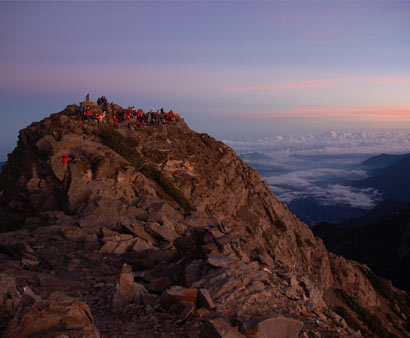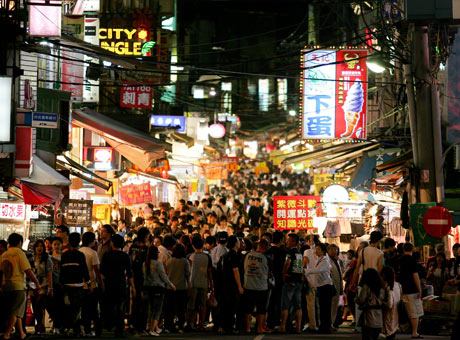Taiwan
Country statistics

Land area: 12,456 sq miles (32,261 sq km)
Total area: 13,892 sq miles (35,980 sq km)
Population (2011 est.): 23,071,779 (growth rate: 0.193%); birth rate: 8.9/1000; infant mortality rate: 5.18/1000; life expectancy: 78.32
Capital City: Taipei
Monetary unit: New Taiwan dollar
Languages: Chinese (Mandarin, official), Taiwanese (Min), Hakka dialects
Ethnicity/race: Taiwanese (including Hakka) 84%, mainland Chinese 14%, aborigine 2%
Religions: mixture of Buddhist, Confucian, and Taoist 93%, Christian 4.5%, other 2.5%
Country introduction

The island of Taiwan is located in the Western Pacific between Japan and the Philippines off the south-east coast of China, from which it is separated by the Taiwan Strait. With a total area of about 36,179 sq km (22,480 sq miles), Taiwan is 394 km (244 miles) long and 144 km (89 miles) wide at its widest point.
High mountains over 1,000 m (3,280 ft) consitute about 31% of the island's land area; hills and terraces between 100 m (328 ft) and 1,000 m (3,280 ft) above sea level make up 38%; and alluvial plain below 100 m (328 ft) in elevation, where most communities, farming activities, and industries are concentrated, account for the remaining 31%.
Taiwan's most geographic feature is its 270 km central mountain range, which has more than 200 peaks over 3,000 m (9,842 ft) high. At 3,952 m (12,965 ft), Mount Jade is the highest peak in East Asia. Foothills from the central mountain range lead to tablelands and coast plains in the west and south. The eastern shoreline is relatively steep, and mountains over 1,000 m (3,280 ft) high dominate the island in the north.
Taiwan's subtropical climate is home to an abundance of diverse plant life, including low altitude flora closely related to that found on Southern China, mountain flora similar to that of Western China, and high alpine flora resembling that of the Himalayan region. Acacia is ubiquitous in the lower hills, and bamboo groves and forest are found throughout Central and Northern Taiwan. Native plant species are numerous, accounting for roughly 40% of Taiwan's total vegetation.
The culture

Taiwan today is a rich and wonderful blend of many origins. It incorporates Chinese culture, along with Japanese culture, traditional beliefs and customs and modern Western values.
Taiwan was once dominated by Japan, later it was adopted by China, giving it as a result one of the richest blends of cultural heritage in Asia and anywhere in the World. For the latter half of the 20th Century, Taiwan became an industrialized developed country whose economic growth has been called by many as the 'Taiwan Miracle'.
Mandarin is the official national language and is spoken by the majority of residents. Many of Taiwan's people speak both Mandarin and Taiwanese, a ancient language spoken since centuries ago. As far as religion goes, Taiwan protects people's freedom of religion and practices of belief. The main religion is Chinese Folk Religion as well as Buddhism, Confucianism and Taoism. There are also Christians, Protestants and Catholics. Confucianism is a major part of Taiwanese life as it serve a great deal on how people live their life.
Taiwan is noticeable for its high density of 24 hour convenience stores. Due to their common and prominent availability, they provide services on behalf of financial institutions and many government agencies. These stores serve a very useful outlet for the rushed and busy population.
Taiwan's large population has spawned a very active and vibrant 24 hour social lifte. From avid night life, cultural attractions and a city that always has something for everyone. As for recreation, Karaoke is immensely popular, although here it is called KTV. People from all ages enjoy singing karaoke, or playing the traditional game of Mahjong. Taiwan's cultural expression in the past few decades has experienced a great deal of renewal when it comes to identity in many areas such as music, art and cuisine.
Attractions & landmarks

Taiwan's capital is a city called Taipei, this city is home to about 6 million inhabitants and is easily the busiest city on the island. Although there are definite problems with pollution and traffic congestion, Taipei has the biggest selection of shops, bars and nightlife on the island. The city centre also offers a selection of tourist attractions from the National Museum of History to Fu Hsing Dramatic Arts Academy, here visitor have the opportunity to take a tour of this remarkable institution and watch tradition Chinese opera, acrobatics and theatre. The city also houses what is reputably the finest example of temple architecture in the country in the form of the Lungshan or "Dragon Mountain" temple. This temple was founded in 1740 and was built as a tribute to Kuan Yin, the goddess of mercy.
The Taipei 101 scyscraper is a modern architectural wonder of Taiwan. It is the tallest building in the world. In many aspects, the new building is the most technologically advanced skyscraper constructed to date. The building features fiber-optic and satellite Internet connections allowing speeds of up to 1 gigabit per second. The tower is designed to endure earthquakes above seven on the Richter scale, and once a century super typhoons. A 660 metric tons (730 tons) tuned mass damper is held at the 88th floor, stabilizing the tower against Earthquakes, typhoons, and wind. The damper can reduce up to 40% of the tower's movements.
No Asian country would be complete without its temple town, in Taiwan the town of Tainan fills the niche nicely. There are over 200 temples in and around the town, many still in active use. Highlights include the Taoist East Mountain temple where worshippers come to exercise ghosts or to communicate with their ancestors and the Mito temple which is famous for its statue of the 100 armed goddess of mercy Kuan Yin. Visitors looking to witness actual Buddhist practices can head to Luerhmen. This suburb contains three large temples which are in current use. At each of them visitors have the opportunity to have their name engraved on a temple artefact in exchange for a donation to maintenance costs. The Woozland water park is close by and offers an excellent way to unwind after a hard day's temple touring.
A short ferry hop from the south-east coast of Taiwan takes visitors to the beautiful volcanic island of Lanyu. This tiny island has a tropical climate and is inhabited by Yami aborigines. The Yami speak their own dialect which is totally dissimilar to Chinese, whilst modern culture has influenced the Yami people there is still a lot of aborigine culture present. For example the Yami build their homes underground to avoid typhoons. There is enough of a Chinese influence to find restaurants and taxis so inexperienced travellers shouldn't feel too out of their depth when exploring this pretty little island.